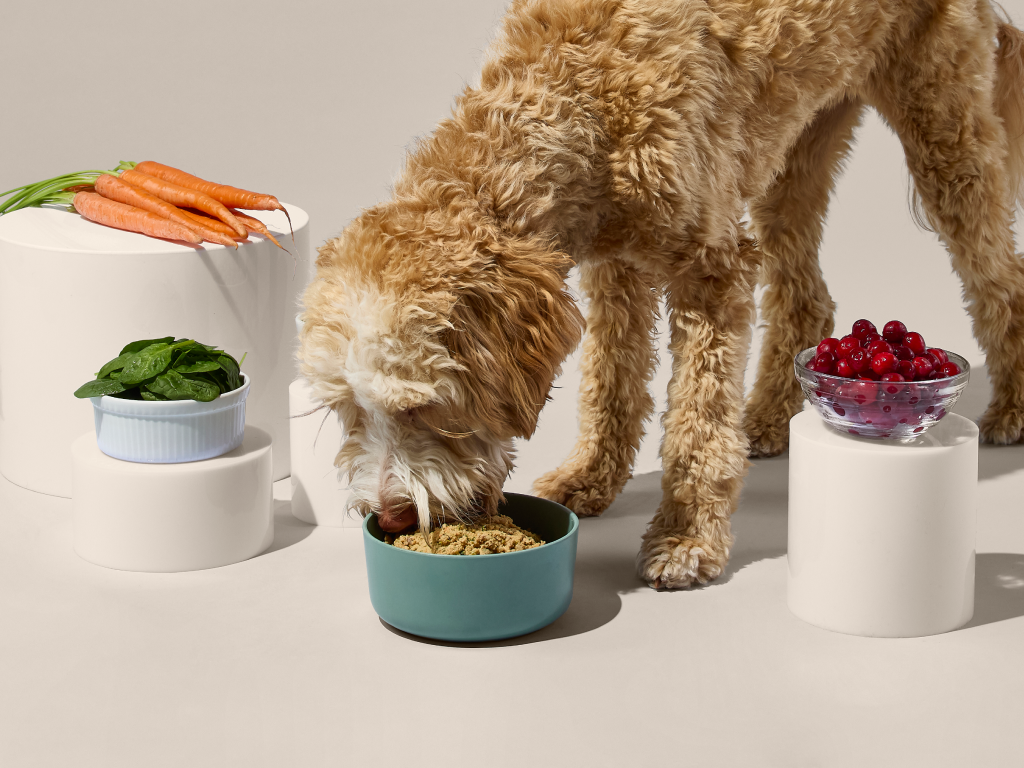Hey Ollie blog readers! We’re offering you an exclusive 60% OFF your starter box! Try now!
When bringing home a new puppy, one of the most important decisions you’ll make is what to put in their bowl. Puppies have significantly different nutritional needs compared to adult dogs, and understanding these differences is crucial for supporting their healthy development. Read on to learn more about these differences, and how the proper nutrition sets the foundation for a longer, happier life.
The Science Behind Puppy Nutrition Requirements
Puppies undergo tremendous growth in their first year of life. During this critical period, they need more calories, protein, fat, and certain minerals than adult dogs to support proper development of bones, muscles, organs, and cognitive function.
Higher Protein Content
Protein is the building block for your puppy’s growing muscles and tissues. According to the Association of American Feed Control Officials (AAFCO), puppy food should contain a minimum of 22.5% protein, compared to only 18% for adult dog food[1][2]. This higher protein content supports the rapid cell growth and tissue development that puppies experience.
The quality of protein matters just as much as the quantity. Complete proteins containing all essential amino acids are vital for proper development. High-quality animal proteins like chicken, beef, and fish provide the amino acid profile puppies need for optimal growth.
Increased Fat and Calorie Content
Puppies are bundles of energy that require more calories per pound of body weight than adult dogs. AAFCO recommends puppy food contain a minimum of 8.5% fat, while adult dog food needs only 5.5%[1][2]. This difference exists because:
- Puppies have higher metabolic rates
- They’re constantly building new tissue
- They typically have higher activity levels
These additional calories from fat provide the energy puppies need for growth and play without depleting the resources needed for development. Fat also helps with the absorption of fat-soluble vitamins and supports brain development.
Essential Minerals for Bone Development
Calcium and phosphorus are particularly important for puppies, especially during the critical bone development phase. AAFCO recommends a minimum of 1.2% calcium in dry puppy food, compared to just 0.5% for adult dog food[1]. This higher calcium content supports:
- Proper bone formation and density
- Healthy tooth development
- Nerve function and muscle contraction
However, the balance between calcium and phosphorus is crucial. Too much calcium can be as problematic as too little, particularly in large breed puppies where it may contribute to skeletal abnormalities.
Critical Nutrients for Brain and Eye Development
Puppies are not just growing physically—their brains and sensory systems are developing rapidly as well. Certain nutrients play key roles in this cognitive and sensory development.
DHA for Cognitive Function
DHA (docosahexaenoic acid) is an omega-3 fatty acid that’s essential for brain and eye development in puppies. Puppies initially get DHA from their mother’s milk, but after weaning, they need to get it from their food[1].
Studies published in the Journal of the American Veterinary Medical Association have shown that diets fortified with DHA can improve cognitive and retinal functions in young dogs[1]. This nutrient supports:
- Neural development and function
- Retinal health and visual acuity
- Learning ability and trainability
Quality puppy foods include fish oil or other sources of DHA to support this crucial aspect of development.
When to Transition from Puppy to Adult Food
Understanding when to switch from puppy to adult food is just as important as knowing the nutritional differences between them. Feeding puppy food for too long can lead to excess weight gain, while switching too early might deprive your growing pup of needed nutrients.
Timing Based on Breed Size
The appropriate time to transition depends largely on your dog’s breed size:
- Small breeds (under 20 pounds): Generally reach physical maturity around 9-12 months
- Medium breeds (20-50 pounds): Usually mature between 12-14 months
- Large breeds (50-100 pounds): May take 12-16 months to reach maturity
- Giant breeds (over 100 pounds): Can take up to 18-24 months to fully mature
As your puppy approaches maturity, their metabolism begins to slow down. They no longer need the higher fat, protein, and calorie content of puppy food—continuing to feed puppy food during adulthood can lead to weight gain and obesity[4].
Signs Your Puppy Is Ready for Adult Food
Beyond age and breed considerations, watch for these indicators that your puppy may be ready to transition to adult food:
- Growth rate has slowed significantly
- They’ve reached about 90% of their expected adult weight
- For females, after their first heat cycle
- They’ve reached skeletal maturity (especially important for large breeds)
Always consult with your veterinarian before making the switch, as they can provide guidance specific to your puppy’s individual needs and development.
The Risks of Improper Nutrition
Feeding adult dog food to puppies or continuing puppy food too long into adulthood can have consequences for your dog’s health.
Potential Issues from Feeding Adult Food to Puppies
When puppies don’t receive the proper nutrition formulated for their developmental needs, they may experience:
- Stunted growth or improper bone development
- Weakened immune system
- Cognitive development issues
- Energy deficiencies
- Vitamin and mineral imbalances
Problems with Extending Puppy Food into Adulthood
Conversely, feeding puppy food to adult dogs can lead to:
- Weight gain and obesity
- Excessive strain on organs
- Joint problems from carrying excess weight
- Potential for nutrient excesses that tax the kidneys
Fresh Food Options for Growing Puppies
While traditional commercial puppy foods meet the basic AAFCO standards, many pet parents are exploring fresh food options that can provide high-quality nutrition in more digestible forms.
Fresh dog food, like that offered by Ollie, can be an excellent option for puppies when properly formulated to meet their specific nutritional needs. Fresh food typically features:
- Whole food ingredients with minimal processing
- Higher bioavailability of nutrients
- No artificial preservatives or fillers
- Human-grade ingredients that meet higher quality standards
When considering fresh food for your puppy, look for options specifically formulated for puppies or that can be customized based on your puppy’s age, breed, and projected adult size.
Transitioning Between Puppy and Adult Foods
When the time comes to switch from puppy to adult food, a gradual transition is essential to prevent digestive upset.
Recommended Transition Schedule
Follow this schedule to safely transition your dog to new food:
- Days 1-2: 75% current food, 25% new food
- Days 3-4: 50% current food, 50% new food
- Days 5-6: 25% current food, 75% new food
- Day 7+: 100% new food
If you notice any digestive issues during the transition, slow down the process and extend each step by a few days.
Frequently Asked Questions
Is it harmful to feed my puppy adult dog food?
Yes, it can be harmful. Adult dog food lacks the higher levels of protein, fat, calories, and specific nutrients like DHA and calcium that puppies need for proper development[1][3].
How many times a day should I feed my puppy?
Most puppies benefit from being fed three to four times a day until about six months of age. From six months to a year, twice-daily feeding is typically appropriate. The exact schedule may vary based on your puppy’s breed size and individual needs.
Can I mix puppy food and adult dog food if I have multiple dogs?
It’s best to feed each dog the appropriate food for their life stage. Puppy food has more calories and different nutrient levels than adult food. Feeding adult dogs puppy food can lead to weight gain, while puppies may not get adequate nutrition from adult food[4].
What ingredients should I avoid in puppy food?
Avoid puppy foods with generic meat by-products, artificial colors and flavors, excessive fillers like corn and wheat, BHA/BHT preservatives, and propylene glycol. Look for foods with named meat sources (like chicken or beef) as the first ingredient.
How do I know if my puppy is getting proper nutrition?
Signs of good nutrition include appropriate weight gain, a shiny coat, good energy levels, healthy stools, and meeting developmental milestones. Your veterinarian can help assess whether your puppy is growing appropriately and receiving adequate nutrition.
Providing your puppy with the right nutrition during their critical growth period sets the foundation for a lifetime of health. Understanding the differences between puppy and adult dog nutrition helps ensure your puppy receives the specific nutrients they need for proper development. Whether you choose traditional puppy food or a fresh food option like Ollie that’s formulated for puppies, the most important factor is ensuring the diet meets all of your growing puppy’s nutritional requirements.
Citations
[1] https://www.purina.com/articles/dog/puppy/feeding/puppy-food-vs-adult-dog-food
[2] https://www.pethonesty.com/blogs/blog/key-differences-between-puppy-and-adult-dog-food
[3] https://bluebuffalo.com/articles/dog/puppy-feeding-guidelines/
Tagged As:

The nutrition your dog needs,
the food they want.

Enjoying our articles? Subscribe our Newsletters and get new articles directly to your inbox
You might also like
17 October 2025
6 MINS READ
Vital Fresh Dog Food Benefits for Your Dog’s Wellness
A longer, happier, healthier life starts with what’s in your dog’s bowl. Nutrition is the foundation of canine wellness, and what you choose to feed your pup has profound, lasting effects on t…
by Ollie Pets
29 September 2025
6 MINS READ
How Is Fresh Dog Food Made?
Unlike standard kibble that undergoes high-heat processing, fresh dog food maintains the natural integrity of ingredients while avoiding artificial additives and fillers. But what exactly goes int…
by Ollie Pets
29 September 2025
7 MINS READ
Is Lamb a Good Protein for Sensitive Stomachs?
Lamb provides significant nutritional benefits for dogs, particularly for pups with sensitive stomachs who need a specialized diet. This protein-rich meat offers an excellent alternative for pups …
by Ollie Pets







